When Did Michigan Start Requiring Handguns Be Registered?

The United States has more immigrants than any other country in the earth. Today, more than 40 meg people living in the U.S. were born in another country, accounting for about i-fifth of the world's migrants. The population of immigrants is also very diverse, with just about every state in the world represented among U.S. immigrants.
Pew Research Center regularly publishes statistical portraits of the nation'due south strange-born population, which include historical trends since 1960. Based on these portraits, here are answers to some key questions about the U.South. immigrant population.
How many people in the U.S. are immigrants?
The U.Due south. foreign-born population reached a record 44.eight one thousand thousand in 2018. Since 1965, when U.S. clearing laws replaced a national quota system, the number of immigrants living in the U.Due south. has more than quadrupled. Immigrants today business relationship for xiii.7% of the U.S. population, nearly triple the share (four.8%) in 1970. However, today's immigrant share remains beneath the record 14.8% share in 1890, when nine.ii million immigrants lived in the U.Southward.

What is the legal condition of immigrants in the U.S.?

Most immigrants (77%) are in the country legally, while most a quarter are unauthorized, according to new Pew Enquiry Center estimates based on census data adjusted for undercount. In 2017, 45% were naturalized U.S. citizens.
Some 27% of immigrants were permanent residents and v% were temporary residents in 2017. Another 23% of all immigrants were unauthorized immigrants. From 1990 to 2007, the unauthorized immigrant population more than tripled in size – from iii.5 million to a record high of 12.2 meg in 2007. By 2017, that number had declined by i.7 million, or 14%. There were 10.v million unauthorized immigrants in the U.South. in 2017, bookkeeping for 3.2% of the nation's population.
The decline in the unauthorized immigrant population is due largely to a fall in the number from Mexico – the unmarried largest group of unauthorized immigrants in the U.S. Between 2007 and 2017, this group decreased by 2 meg. Meanwhile, in that location was a rise in the number from Central America and Asia.
Practice all lawful immigrants choose to become U.S. citizens?
Not all lawful permanent residents cull to pursue U.Southward. citizenship. Those who wish to do so may apply after meeting sure requirements, including having lived in the U.S. for five years. In financial year 2019, about 800,000 immigrants applied for naturalization. The number of naturalization applications has climbed in recent years, though the annual totals remain below the 1.4 one thousand thousand applications filed in 2007.
More often than not, virtually immigrants eligible for naturalization utilize to become citizens. Still, Mexican lawful immigrants have the everyman naturalization rate overall. Language and personal barriers, lack of interest and financial barriers are among the peak reasons for choosing not to naturalize cited by Mexican-born green card holders, co-ordinate to a 2015 Pew Research Centre survey.
Where do immigrants come up from?

Mexico is the elevation origin state of the U.S. immigrant population. In 2018, roughly 11.2 million immigrants living in the U.S. were from in that location, bookkeeping for 25% of all U.S. immigrants. The next largest origin groups were those from Red china (6%), India (six%), the Philippines (4%) and El Salvador (3%).
By region of birth, immigrants from Asia combined accounted for 28% of all immigrants, shut to the share of immigrants from United mexican states (25%). Other regions make up smaller shares: Europe, Canada and other North America (13%), the Caribbean area (10%), Central America (viii%), South America (7%), the Heart East and Due north Africa (iv%) and sub-Saharan Africa (5%).
Who is arriving today?

More than i million immigrants get in in the U.S. each year. In 2018, the height country of origin for new immigrants coming into the U.Due south. was Prc, with 149,000 people, followed by India (129,000), Mexico (120,000) and the Philippines (46,000).
By race and ethnicity, more Asian immigrants than Hispanic immigrants have arrived in the U.S. in well-nigh years since 2009. Immigration from Latin America slowed post-obit the Great Recession, particularly for United mexican states, which has seen both decreasing flows into the United States and large flows back to Mexico in recent years.
Asians are projected to go the largest immigrant group in the U.S. by 2055, surpassing Hispanics. Pew Research Heart estimates indicate that in 2065, those who place as Asian will brand up some 38% of all immigrants; equally Hispanic, 31%; White, xx%; and Black, 9%.
Is the immigrant population growing?

New immigrant arrivals accept fallen, mainly due to a decrease in the number of unauthorized immigrants coming to the U.S. The drop in the unauthorized immigrant population can primarily be attributed to more Mexican immigrants leaving the U.S. than coming in.
Looking forrad, immigrants and their descendants are projected to business relationship for 88% of U.Due south. population growth through 2065, bold current immigration trends proceed. In addition to new arrivals, U.S. births to immigrant parents will be important to future growth in the land'southward population. In 2018, the percent of women giving birth in the past yr was college among immigrants (vii.5%) than among the U.S. born (5.7%). While U.S.-born women gave birth to more than iii 1000000 children that year, immigrant women gave nascency to almost 760,000.
How many immigrants have come to the U.S. as refugees?

Since the creation of the federal Refugee Resettlement Program in 1980, near iii million refugees have been resettled in the U.S. – more any other country.
In fiscal 2019, a total of 30,000 refugees were resettled in the U.S. The largest origin group of refugees was the Democratic republic of the congo, followed by Burma (Myanmar), Ukraine, Eritrea and Afghanistan. Among all refugees admitted in financial year 2019, 4,900 are Muslims (16%) and 23,800 are Christians (79%). Texas, Washington, New York and California resettled more than a quarter of all refugees admitted in fiscal 2018.
Where do nigh U.S. immigrants live?
Nearly half (45%) of the nation's immigrants live in just three states: California (24%), Texas (11%) and Florida (ten%). California had the largest immigrant population of any country in 2018, at 10.half dozen million. Texas, Florida and New York had more than than 4 million immigrants each.
In terms of regions, almost ii-thirds of immigrants lived in the W (34%) and South (34%). Roughly one-5th lived in the Northeast (21%) and eleven% were in the Midwest.
In 2018, most immigrants lived in just 20 major metropolitan areas, with the largest populations in the New York, Los Angeles and Miami metro areas. These top 20 metro areas were home to 28.7 1000000 immigrants, or 64% of the nation's full strange-born population. Most of the nation's unauthorized immigrant population lived in these top metro areas too.
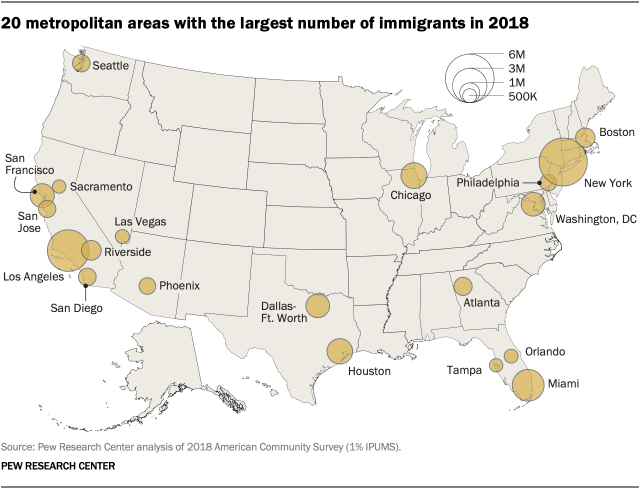
How practice immigrants compare with the U.S. population overall in education?
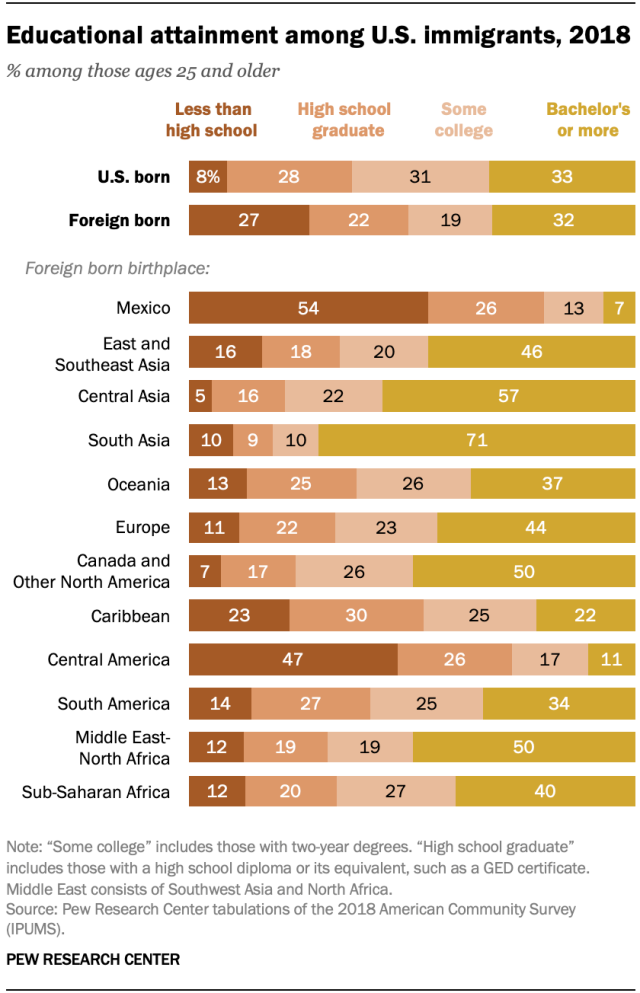
Immigrants in the U.S. as a whole take lower levels of pedagogy than the U.S.-born population. In 2018, immigrants were over 3 times as probable equally the U.Southward. born to accept not completed high schoolhouse (27% vs. 8%). All the same, immigrants were simply as probable as the U.Due south. born to take a bachelor's degree or more (32% and 33%, respectively).
Educational attainment varies amongst the nation'due south immigrant groups, peculiarly across immigrants from different regions of the world. Immigrants from Mexico and Central America are less likely to be loftier school graduates than the U.Southward. built-in (54% and 47%, respectively, do non have a high schoolhouse diploma, vs. eight% of U.South. born). On the other hand, immigrants from every region except United mexican states, the Caribbean and Central America were as probable as or more probable than U.Due south.-born residents to have a bachelor's or avant-garde degree.
Amidst all immigrants, those from South Asia (71%) were the most probable to take a bachelor'south degree or more. Immigrants from Mexico (7%) and Central America (11%) were the least probable to have a bachelor's or college.
How many immigrants are working in the U.S.?

In 2017, about 29 million immigrants were working or looking for work in the U.South., making up some 17% of the total civilian labor forcefulness. Lawful immigrants made up the bulk of the immigrant workforce, at 21.two 1000000. An boosted vii.vi meg immigrant workers are unauthorized immigrants, less than the total of the previous year and notably less than in 2007, when they were viii.2 meg. They alone business relationship for 4.six% of the civilian labor strength, a dip from their top of v.4% in 2007. During the same period, the overall U.Southward. workforce grew, as did the number of U.S.-born workers and lawful immigrant workers.
Immigrants are projected to bulldoze future growth in the U.S. working-age population through at to the lowest degree 2035. As the Baby Blast generation heads into retirement, immigrants and their children are expected to start a decline in the working-age population by adding most xviii million people of working age between 2015 and 2035.
How well exercise immigrants speak English?
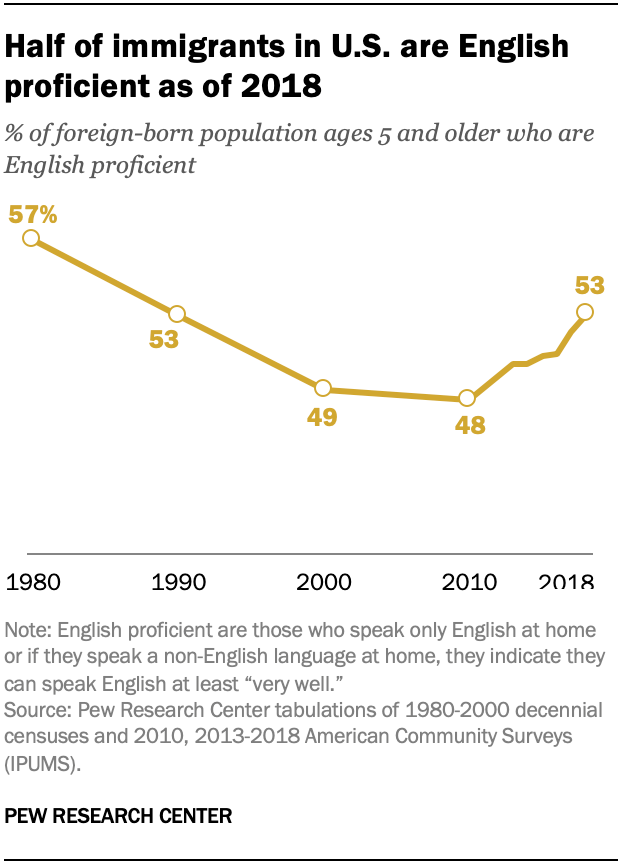
Among immigrants ages v and older in 2018, one-half (53%) are proficient English speakers – either speaking English very well (37%) or only speaking English at home (17%).
Immigrants from Mexico have the lowest rates of English proficiency (34%), followed by those from Central America (35%), East and Southeast Asia (50%) and S America (56%). Immigrants from Canada (96%), Oceania (82%), Europe (75%) and sub-Saharan Africa (74%) have the highest rates of English proficiency.
The longer immigrants have lived in the U.S., the greater the likelihood they are English proficient. Some 47% of immigrants living in the U.S. v years or less are proficient. By contrast, more than half (57%) of immigrants who take lived in the U.S. for 20 years or more are proficient English speakers.
Amongst immigrants ages v and older, Spanish is the most commonly speech. Some 42% of immigrants in the U.S. speak Spanish at home. The top five languages spoken at home among immigrants outside of Spanish are English only (17%), followed by Chinese (6%), Hindi (5%), Filipino/Tagalog (iv%) and French (3%).
How many immigrants have been deported recently?
Effectually 337,000 immigrants were deported from the U.S. in fiscal 2018, up since 2017. Overall, the Obama administration deported about 3 million immigrants betwixt 2009 and 2016, a significantly higher number than the two million immigrants deported by the Bush administration between 2001 and 2008. In 2017, the Trump assistants deported 295,000 immigrants, the everyman total since 2006.
Immigrants bedevilled of a criminal offence made up the less than half of deportations in 2018, the most recent twelvemonth for which statistics by criminal status are available. Of the 337,000 immigrants deported in 2018, some 44% had criminal convictions and 56% were not bedevilled of a crime. From 2001 to 2018, a majority (sixty%) of immigrants deported take non been bedevilled of a criminal offense.
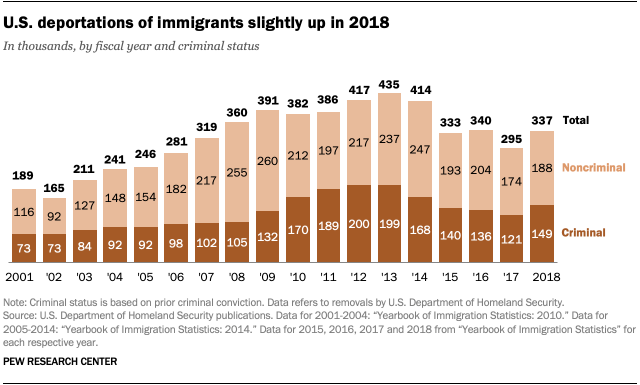
How many immigrant apprehensions accept place at the U.Southward.-United mexican states border?
The number of apprehensions at the U.S.-Mexico border has doubled from fiscal 2018 to fiscal 2019, from 396,579 in fiscal 2018 to 851,508 in fiscal 2019. Today, there are more apprehensions of non-Mexicans than Mexicans at the edge. In fiscal 2019, apprehensions of Central Americans at the border exceeded those of Mexicans for the 4th sequent year. The first fourth dimension Mexicans did non make upwardly the bulk of Border Patrol apprehensions was in 2014.
How exercise Americans view immigrants and clearing?
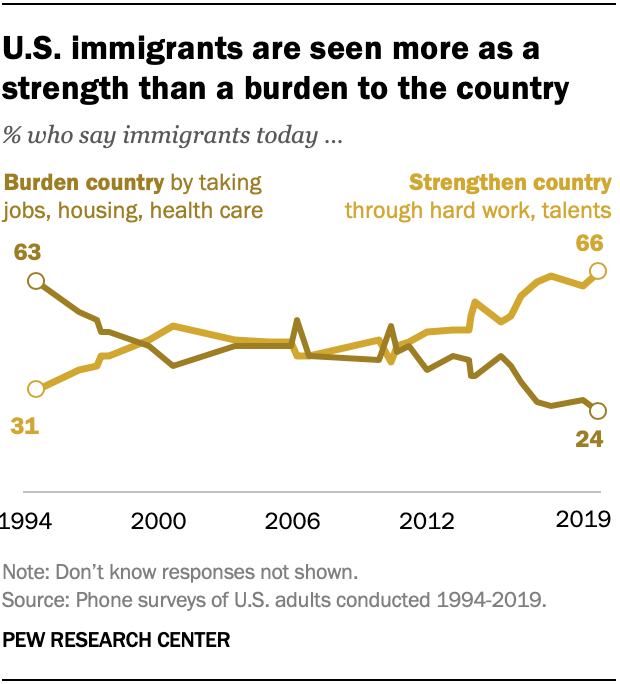
While immigration has been at the forefront of a national political debate, the U.S. public holds a range of views about immigrants living in the country. Overall, a bulk of Americans accept positive views about immigrants. About two-thirds of Americans (66%) say immigrants strengthen the country "because of their difficult piece of work and talents," while about a quarter (24%) say immigrants burden the state by taking jobs, housing and wellness care.
However these views vary starkly by political affiliation. Among Democrats and Autonomous-leaning independents, 88% think immigrants strengthen the country with their hard work and talents, and but 8% say they are a burden. Among Republicans and Republican-leaning independents, 41% say immigrants strengthen the land, while 44% say they burden information technology.
Americans were divided on future levels of immigration. A quarter said legal immigration to the U.Southward. should be decreased (24%), while one-tertiary (38%) said immigration should be kept at its nowadays level and about another third (32%) said clearing should exist increased.
Note: This is an update of a postal service originally published May three, 2017, and written by Gustavo López, a sometime research analyst focusing on Hispanics, immigration and demographics; and Kristen Bialik, a former research banana.
CORRECTION (Sept. 21, 2020): An update to the methodology used to tabulate figures in the nautical chart "Among new immigrant arrivals, Asians outnumber Hispanics" has inverse all figures from 2001 and 2012. This new methodology has as well allowed the inclusion of the effigy from 2000. Furthermore, the before version of the nautical chart incorrectly showed thepartial year shares of Hispanic and Asian recent arrivals in 2015; the correctedcomplete year shares are 31% and 36%, respectively.
Abby Budiman is a former research annotator focusing on race and ethnicity inquiry at Pew Research Middle.
Source: https://www.pewresearch.org/fact-tank/2020/08/20/key-findings-about-u-s-immigrants/
Posted by: gamblindrined.blogspot.com


0 Response to "When Did Michigan Start Requiring Handguns Be Registered?"
Post a Comment